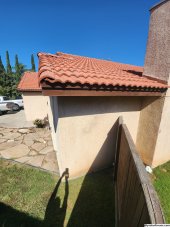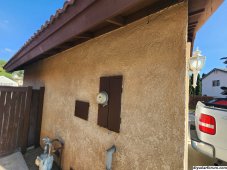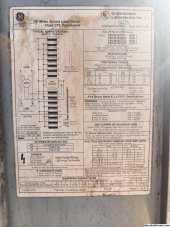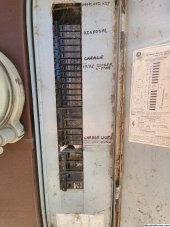I'd like to DIY install solar on my Riverside California home.
I've done a little research, need to do more. Hopefully I haven't already made a big mistake. I purchased 12 solar panels. The panels are Longi LR4-60HBP-350M. Are these ok?
I don't want to change out my service/breaker panel unless I have to. It's Outside, flush mounted, in stucco. My panel appears to be rated for 125amps and currently has a 100Amp main breaker. I read somewhere that I can change out the 100Amp for a lower amperage breaker, say an 80Amp. I believe that would allow me to supply a maximum of 45Amps from solar. Is that correct? Or can I go over that 125 amp rating? I think I read 120% (I need to start taking notes :-(.
I have a lot of open roof area on my single story 1750sqft home. Unfortunately, I don't have a South facing roof. I have 2 large areas, one facing east, the other west. Will that work?
The roof is tile. I've seen several videos on how to install the rail roof hooks. Every one of the videos shows a different type of hook and different ways to seal them to the roof. Some use no flashing. Some use felt, some use a rubber like flashing and some use metal. How do I figure out what kind of hooks I need? Will all of the hooks made for tile work? Is there a particular brand of hooks and rails that are most commonly used? Does it depend on the type of tile I have?
I plan on using Enphase micro inverters, but only because those seem to be the most popular and readily available. Thinking 7 series since my panels are only 350W. Are they a good choice? Is it safe to buy used? Will the city allow used? Or should I just go new?
I know each panel gets an inverter, and that they link together. I'm fuzzy on how that power gets down to the panel below. I know I need a water tight connection box on the roof to connect the wire from the inverters to the wire going through the attic and finally outsider. I'll need some kind of a water proof roof penetration. Can I use emt through the attic? Could I use Romex without conduit? (Can't put romex in conduit, but I could put junction boxes in the attic?? Or do I need to run rigid?
Once outside (stucco), do I need riged or can I run emt? Am I only running the power cables or is there also a logic cable that must be run?
Outside, I know I need a disconnect, and a "magic Enphase box" (need to learn a lot more about that).
Reading several posts on this site, I've learned that I should plan, get the plans approved and then purchase the components. Oops, should have waited on the panels. Got them for $140ea. cash, which I've since learned is about full retail. They're new from an installer that went out of business. If I had it to do over, I would have purchased from a reputable supplier with a warranty (and a receipt).




Any advice will be greatly appreciated, even just a point to some good info. I'm old but still in pretty good shape. Hiring this out doesn't make financial sense. I won't live long enough to pay it off with the savings. Thanks in advance.
Oh, and the house has a whole house generator with a separate breaker panel and an automatic switch. There is a problem with it, but that's another post for another forum
I've done a little research, need to do more. Hopefully I haven't already made a big mistake. I purchased 12 solar panels. The panels are Longi LR4-60HBP-350M. Are these ok?
I don't want to change out my service/breaker panel unless I have to. It's Outside, flush mounted, in stucco. My panel appears to be rated for 125amps and currently has a 100Amp main breaker. I read somewhere that I can change out the 100Amp for a lower amperage breaker, say an 80Amp. I believe that would allow me to supply a maximum of 45Amps from solar. Is that correct? Or can I go over that 125 amp rating? I think I read 120% (I need to start taking notes :-(.
I have a lot of open roof area on my single story 1750sqft home. Unfortunately, I don't have a South facing roof. I have 2 large areas, one facing east, the other west. Will that work?
The roof is tile. I've seen several videos on how to install the rail roof hooks. Every one of the videos shows a different type of hook and different ways to seal them to the roof. Some use no flashing. Some use felt, some use a rubber like flashing and some use metal. How do I figure out what kind of hooks I need? Will all of the hooks made for tile work? Is there a particular brand of hooks and rails that are most commonly used? Does it depend on the type of tile I have?
I plan on using Enphase micro inverters, but only because those seem to be the most popular and readily available. Thinking 7 series since my panels are only 350W. Are they a good choice? Is it safe to buy used? Will the city allow used? Or should I just go new?
I know each panel gets an inverter, and that they link together. I'm fuzzy on how that power gets down to the panel below. I know I need a water tight connection box on the roof to connect the wire from the inverters to the wire going through the attic and finally outsider. I'll need some kind of a water proof roof penetration. Can I use emt through the attic? Could I use Romex without conduit? (Can't put romex in conduit, but I could put junction boxes in the attic?? Or do I need to run rigid?
Once outside (stucco), do I need riged or can I run emt? Am I only running the power cables or is there also a logic cable that must be run?
Outside, I know I need a disconnect, and a "magic Enphase box" (need to learn a lot more about that).
Reading several posts on this site, I've learned that I should plan, get the plans approved and then purchase the components. Oops, should have waited on the panels. Got them for $140ea. cash, which I've since learned is about full retail. They're new from an installer that went out of business. If I had it to do over, I would have purchased from a reputable supplier with a warranty (and a receipt).





Any advice will be greatly appreciated, even just a point to some good info. I'm old but still in pretty good shape. Hiring this out doesn't make financial sense. I won't live long enough to pay it off with the savings. Thanks in advance.
Oh, and the house has a whole house generator with a separate breaker panel and an automatic switch. There is a problem with it, but that's another post for another forum


